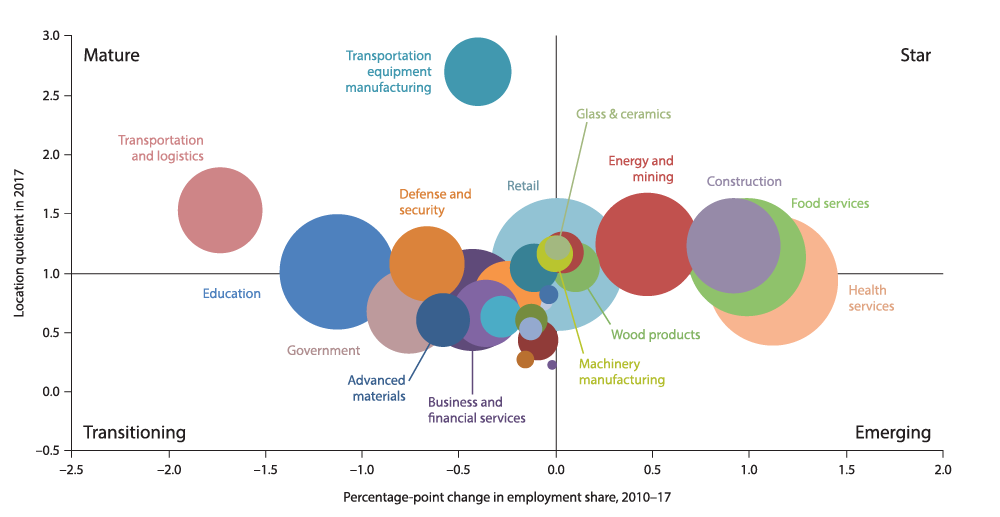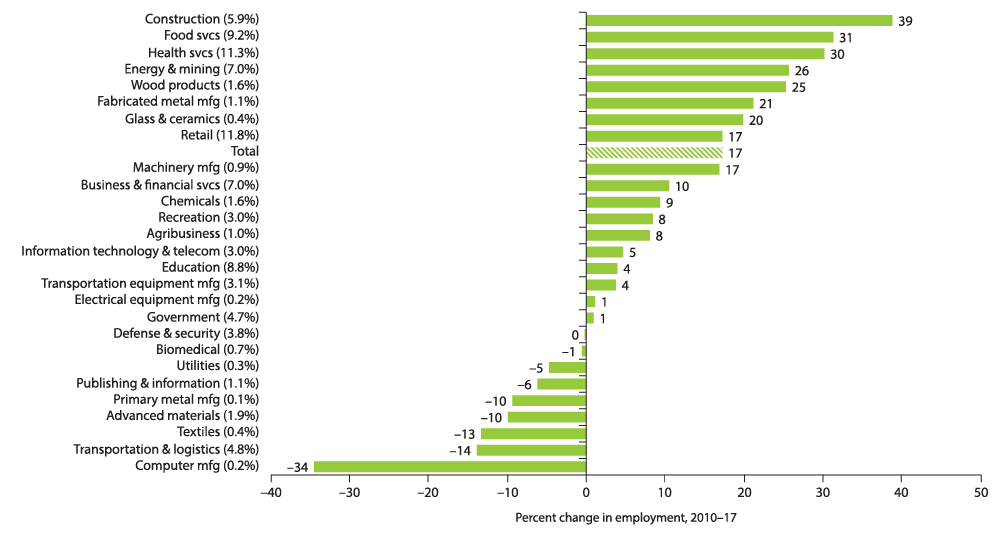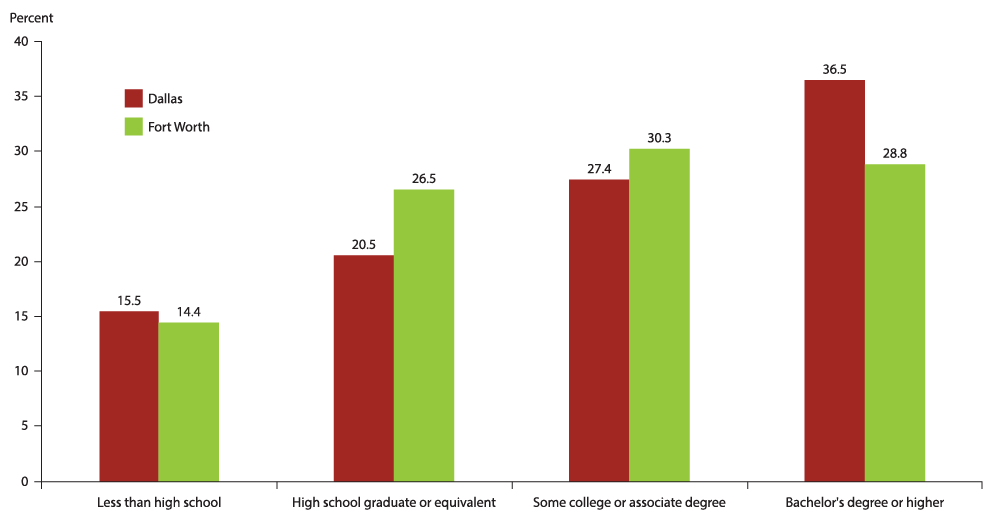At the heart of Texas: Cities’ industry clusters drive growth
Houston–The Woodlands–Sugar Land: Texas’ Gulf Coast hub and nation’s energy capital
- Print version
- Additional tables: Houston location quotients, employment shares, average annual earnings, demographics
At a glance

Population (2017): |
6.9 million |
Population growth (2010–17): |
15.9 percent (Texas: 12.1 percent) |
Median household income (2017): |
$63,802 (Texas: $59,206) |
National MSA rank (2017): |
No. 5* |
Kauffman Startup Activity Index rank (2017): |
No. 9* |
| *The Houston–The Woodlands–Sugar Land metropolitan statistical area (MSA) encompasses Austin, Brazoria, Chambers, Fort Bend, Galveston, Harris, Liberty, Montgomery and Waller counties. The Kauffman Startup Activity Index, a measure of business creation in the 40 largest U.S. metropolitan areas, is further explained in the appendix. | |
- Houston is Texas’ second-largest metro, accounting for one-quarter of the state’s jobs and 30 percent of its economic output.
- Houston began as a port city, rising to prominence as one of the top three busiest deepwater ports in the U.S.
- Due to its proximity to Spindletop, site of the legendary 1901 oil strike, the Houston area quickly became the energy capital of the U.S. and home to oil companies, refineries and petrochemical plants. While the energy industry remains the dominant cluster, the metro has diversified. Manufacturing, chemicals and health industries have grown in importance.
- A series of catastrophic flooding events has prompted reevaluation of the area’s basic needs and plans. New building regulations and infrastructure investments may raise the region’s cost of housing and doing business.
History: An energy complex emerges from a port city
Houston was founded in 1836 along Buffalo Bayou, a waterway leading to the Gulf of Mexico. At the time, the city was dependent on agriculture and commerce, and most business involved selling supplies to area farmers.[1]
Because Buffalo Bayou was difficult to navigate, trade tended to pass through Galveston, 50 miles away on the coast. Rail lines connected Houston to the countryside, and by 1861, the city was the rail center of southeast Texas. The U.S. government began widening and deepening Buffalo Bayou in 1881, and when the Houston Ship Channel was finally completed in 1914, Houston became a deepwater port, ranking among the top three ports by volume in the U.S. just before World War II.[2]
Drillers struck oil in 1901 at Spindletop, 75 miles to the east near Beaumont, catalyzing the oil boom in Texas. Sinclair Oil Co. built the first major oil refinery in Houston in 1918, and many others followed, constructing facilities along the Houston Ship Channel.
Forty oil companies had Houston offices by 1929. During World War II, demand for petrochemical products skyrocketed, and Houston quickly developed one of the largest petrochemical plant concentrations in the U.S. Houston was an international energy capital by the 1970s, expanding with the oil boom but also contracting during the 1980s bust.
Industry clusters: Energy and related industries dominate
Chart 6.1 shows the composition of industry clusters in Houston, organized by location quotient (LQ), a measure of a cluster’s share of local employment relative to its share nationally. Each cluster is plotted based on employment share change between 2010 and 2017.[3]

NOTE: Bubble size represents industry share of metropolitan statistical area employment.
SOURCES: Texas Workforce Commission; Bureau of Labor Statistics.
Clusters in the “star” quadrant, such as construction, have a large share of employment relative to the nation (an LQ exceeding 1) and are relatively fast growing; “emerging” industries, such as recreation, are smaller relative to the nation (an LQ less than 1) but also fast growing. “Mature” sectors, such as the energy and mining industry, are more concentrated but slower growing; “transitioning” segments, such as government, are smaller relative to the nation and are slower growing.
Energy and related companies—which include oilfield services and refining—by far make up the largest industry group in Houston, employing 12 percent of the workforce, after contracting during the 2015–16 energy bust. As of 2018, Houston had 21 Fortune 500 headquarters, 17 of which are related to oil and gas extraction and processing. Apart from Phillips 66 and ConocoPhillips—whose headquarters are in Houston—the city’s largest employers include units of Exxon Mobil Corp., with 14,000 employees, and Shell Oil Co., with 12,000 employees.[4]
Oilfield manufacturing and services companies that support the energy extraction firms include National Oilwell Varco, Schlumberger and Halliburton. This concentration has spawned significant clusters of machinery and fabricated metal manufacturers.
The chemical industry is another major energy-related cluster, employing 2.4 percent of Houston’s workforce. Leading employers include Dow Chemical Co. and many of the large energy companies, including Exxon Mobil, which also manufacture chemicals.
Houston is a major port city and regional commercial hub. The United Airlines hub, the carrier’s second largest, is located at George Bush Intercontinental Airport and employs 14,200 people in Houston. Southwest Airlines dominates Hobby Airport and has 3,600 local workers.
The health services cluster, accounting for 10.7 percent of Houston’s workforce, has also grown significantly in recent years. Two of the area’s largest employers, with more than 20,000 workers each, are Memorial Hermann Health System and the University of Texas MD Anderson Cancer Center. Though Houston’s concentration of health care workers remains below that of the U.S. (with an LQ of 0.9), employment grew 21 percent from 2010 to 2017 (Chart 6.2).

NOTES: Percent change in employment is shown in whole numbers. Each cluster’s share of total jobs is shown in parentheses (rounded to one decimal place).
SOURCES: Texas Workforce Commission; authors’ calculations.
The major industry clusters in Houston pay significantly more than other industries (Table 6.1). Average annual earnings for energy and mining, for example, were $120,700 in 2017; overall average earnings in Houston were $65,000. Workers employed in the most-concentrated clusters—those with LQs greater than 1—earn on average 40 percent more than workers in less-concentrated clusters ($80,300 versus $57,300). Average real earnings (inflation-adjusted) in Houston grew 3.0 percent from 2010 to 2017. Earnings in the most-concentrated clusters grew more slowly at 2.7 percent.
| Cluster | Houston | U.S. | |||||
| 2010 | 2012 | 2014 | 2016 | 2017 | 2017 | ||
| Energy and mining | 119,894 | 125,444 | 124,557 | 123,673 | 120,706 | 80,900 | |
| Machinery manufacturing | 97,114 | 101,846 | 102,492 | 103,066 | 103,421 | 70,059 | |
| Fabricated metal manufacturing | 63,695 | 67,507 | 67,773 | 65,234 | 66,269 | 55,830 | |
| Chemicals | 100,730 | 103,317 | 106,506 | 111,148 | 113,496 | 72,887 | |
| Construction | 65,995 | 69,062 | 72,861 | 73,834 | 72,883 | 60,742 | |
| Utilities | 119,242 | 124,631 | 126,614 | 124,790 | 134,235 | 107,188 | |
| Transportation and logistics* | 76,050 | 84,102 | 77,871 | 79,562 | 80,508 | 53,761 | |
| Glass and ceramics | 53,149 | 56,688 | 57,244 | 56,232 | 57,804 | 55,398 | |
| Education | 46,750 | 45,968 | 47,670 | 49,880 | 49,985 | 49,322 | |
| Food services | 18,860 | 18,683 | 18,990 | 19,530 | 19,514 | 18,963 | |
| Business and financial services | 101,936 | 103,693 | 105,695 | 104,660 | 104,444 | 100,785 | |
| Advanced materials | 85,835 | 88,217 | 89,508 | 94,195 | 97,136 | 85,695 | |
| Clusters with location quotient >1 | 78,245 | 81,979 | 82,404 | 81,110 | 80,337 | – | |
| Clusters with location quotient <1 | 55,631 | 55,889 | 56,250 | 57,454 | 57,303 | – | |
| Average earnings (total) | 63,031 | 65,474 | 66,707 | 65,399 | 64,953 | 55,375 | |
| *Large increase is due to average earnings in NAICS 486 (pipeline transportation) doubling in second quarter 2012 compared with second quarter 2010. NOTES: Clusters are listed in order of location quotient (LQ); clusters shown are those with LQs greater than 1. Earnings are in 2017 dollars. SOURCES: Texas Workforce Commission; Bureau of Labor Statistics; authors’ calculations. |
|||||||
Demographics: Houston population more diverse
Demographics in Houston—the state’s second-most populous metro, with 6.9 million residents—are more diverse than in the other major metros. Houston’s Hispanic population is as large as the white non-Hispanic population—around 37 percent. The black (non-Hispanic) share, 16.9 percent, and Asian (non-Hispanic) share, 7.6 percent, are higher than in most other Texas metro areas in this report (Chart 6.3).

SOURCE: Census Bureau, 2016 American Community Survey 1-Year Estimates.
As an immigrant gateway city with rapid job growth, Houston’s increasingly diverse industrial base and top universities have made it a popular destination for those relocating from other countries. Apart from the Texas border metros, Houston has the state’s largest foreign-born population share, 23.5 percent. Roughly two-thirds of the foreign born are from Latin America and a fourth are from Asia.
Houston trails Dallas and Austin in the share of the population with a bachelor’s degree or higher. This reflects the abundance of energy industry and manufacturing jobs, many of which pay well but do not require a college degree. However, Houston’s population is more educated than Texas’ overall. Thirty-two percent of Houston’s population holds a bachelor’s degree or higher; the Texas average is 28.9 percent.
Employment: impact of energy booms and busts, storms
The shale oil boom fueled Houston’s rapid postrecession growth. With its high concentration of firms in energy and related industries, Houston’s employment prospects were driven by shale exploration, directly and indirectly.
However, energy-fueled booms are sensitive to price busts. In response to crashing oil prices in late 2014, the Houston economy stalled in 2015 and 2016. Job losses were concentrated not only in goods-producing sectors such as energy and manufacturing, but also in some service sectors such as professional and business services. Houston’s economy bounced back in 2017, with payroll employment expanding 1.9 percent.
In August 2017, Hurricane Harvey wreaked havoc on the middle and upper Texas Gulf Coast, bringing the region to a standstill for a week. The region sustained at least $70 billion in damage, and nearly 100,000 residential structures were flooded. The region also lost an estimated $8.5 billion in economic output—about 1.7 percent of the metro area’s gross domestic product (GDP).[5]
While the economic effects of major storms are generally transitory in thriving economies such as Houston, flooding has been a growing problem in the metro area in recent years. The potential impacts of future weather events have led to substantial public investment and expanded regulation. Harris County voters approved a $2.5 billion flood control program.
Houston has historically bounced back from adversity. It was hard hit by the Great Recession, losing 4.6 percent of its jobs between August 2008 and November 2009. Among the large Texas metros, only Dallas–Fort Worth lost more. However, Houston rebounded strongly, with employment expanding 18.1 percent from December 2009 to December 2014, or 3.4 percent per year. Among the large metros, only Austin came back faster, up 4.0 percent per year during the period.
Firms that directly participate in fossil fuel production, refining and petrochemicals expanded significantly, as did companies that provide support to energy producers, such as machinery manufacturers, construction and real estate firms, and business and financial services enterprises.
Outlook: End of energy recession signals renewed growth
Energy made up 18.4 percent of Houston’s economy (nominal GDP) going into the 2015–16 oil bust, after which the industry hit a low of 9.6 percent of metro GDP in 2016. The oil bust led to severe job losses in the goods-producing sectors, steep declines in energy-related investment and falling demand for business services and commercial real estate, especially office space. That said, the effects of falling oil prices from December 2014 through February 2016 were not nearly as drastic for Houston as those during the 1980s oil bust, reflecting the region’s greater resilience through economic diversification.
Other headwinds for the Houston economy during the last oil bust were low oil prices, the strong dollar and weak global demand, which suppressed export growth. Because Houston is a port city, trade is vital to the economy and supports hundreds of thousands of area jobs, by some estimates.[6] The World Bank estimates that global trade growth strengthened to a six-year high in 2017 after two years of pronounced weakness, and it forecasts annual trade expansion to ease through 2020 due to deceleration in global investment and heightened uncertainty surrounding U.S. trade policy.[7]
Parts of the energy industry are poised to expand. A cycle of petrochemical-plant and liquefied natural gas-terminal openings peaked in 2017. After the comparatively labor-intensive construction phase—expected to taper off by 2020—the plants will require fewer employees as they become operational. The lifting of oil export restrictions has also contributed to a large upswing in related trade activity.
Meanwhile, Houston’s health care industry is expected to grow to support a burgeoning aging population. More than 1-in-10 Houston residents is over age 65, and this cohort is expected to grow significantly in the coming decades as baby boomers age. The world-recognized medical research, highlighted by the MD Anderson Cancer Center, attracts patients from far outside the area. The University of Texas Medical Branch in Galveston is another hub of medical exploration.
—Kristin Davis and Jesse Thompson
| Houston—The Woodlands—Sugar Land Growth Outlook | |
| Drivers | Challenges |
|
|
Notes
- The history of Houston is taken from the Texas State Historical Association's (TSHA) Handbook of Texas, tshaonline.org/handbook/online/articles/hdh03.
- “Houston Ship Channel,” by Marilyn M. Sibley, Handbook of Texas, TSHA, tshaonline.org/handbook/online/articles/rhh11.
- The percentage shares of individual clusters do not add to 100 because some industries are counted in multiple clusters, and some industries are not counted at all based on cluster definitions. (See the appendix for more information.)
- Data on major Houston employers are taken from the Houston Business Journal Book of Lists and the Greater Houston Partnership’s 2017 Houston Facts, www.houston.org/assets/pdf/economy/Houston_Facts_2017.pdf. Nonenergy Fortune 500 companies headquartered in Houston were Sysco, Waste Management, Group 1 Automotive and Quanta Services, www.houston.org/newgen/14_Company_Information/14A%20W001%20Fortune%20500%20Companies.pdf.
- “U.S. Disaster Costs Come Into Clearer Focus,” by Adam Kamins, Moody’s Analytics, 2017, accessed Jan. 20, 2018, www.economy.com/dismal/analysis/todays-economy/298539/US-Disaster-Costs-Come-Into-Clearer-Focus/.
- See the Greater Houston Partnership’s 2018 Houston Employment Forecast, Dec. 8, 2017, www.houston.org/assets/pdf/economy/Employment-Forecast-2018-web.pdf. The total employment impact involves 450,000 jobs.
- Global Economic Prospects, World Bank, January 2018, www.worldbank.org/en/publication/global-economic-prospects.